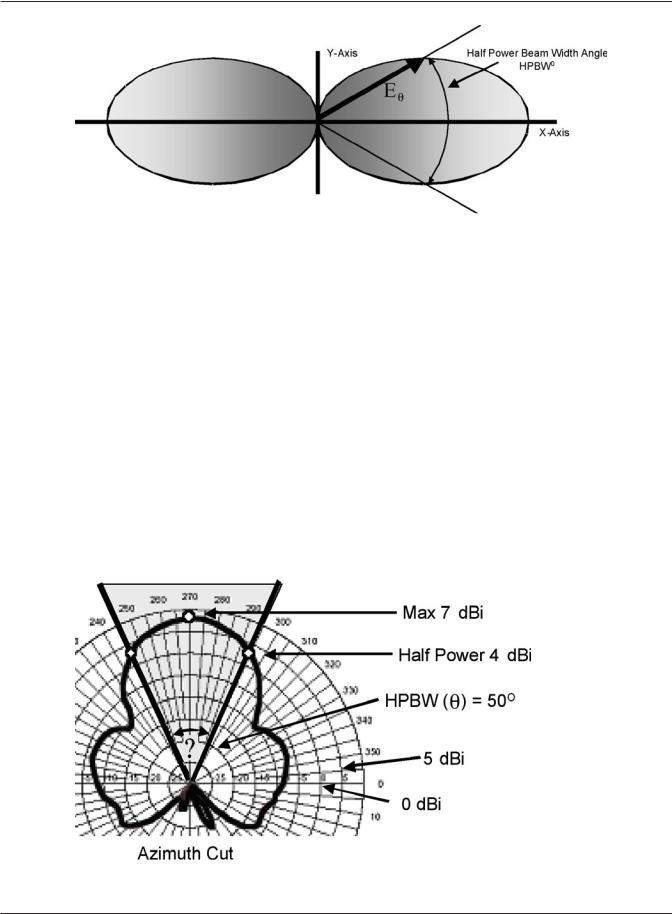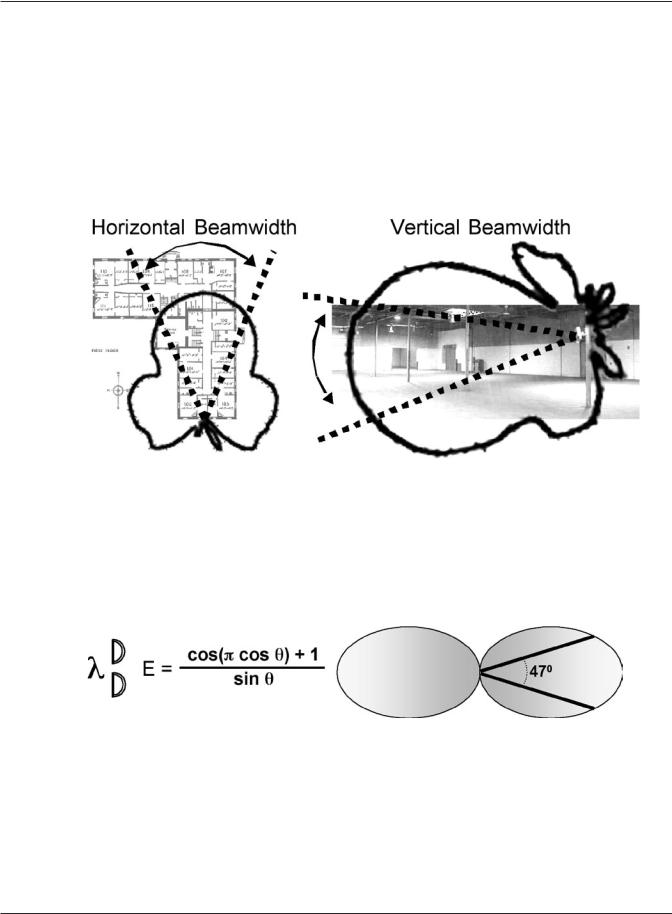
- •Math and Physics for the 802.11 Wireless LAN Engineer
- •About the Author
- •Section 1: Introduction
- •Are You the Professor, or the Chauffeur?
- •Purpose and Perspective
- •Apprehensive Attitudes Resulting from Lack of Knowledge
- •What You’ll Learn in this Paper
- •A Note to the Reader Familiar with the Subject
- •Section 2: Electricity and Electromagnetic Fields
- •Electrical Force
- •Resistance and Reactance
- •Power Measurement
- •Watts, Milliwatts, Decibels, and dBm Units of Measurement
- •Magnetic Fields
- •Figure 2.1 The Magnetic Field Surrounding a Current Carrying Conductor
- •Zeno’s Paradoxes
- •Bardwell’s ERP Paradox
- •Section 3: The Electromagnetic Spectrum
- •Figure 3.1 The Electromagnetic Spectrum
- •The Shape of the Electromagnetic Field
- •Figure 3.2 The Spherical Radiation Pattern of a Theoretical Isotropic Radiator
- •Figure 3.3 The Doughnut-Shape of the Electromagnetic Radiation Pattern
- •Particles and Waves
- •Figure 3.4 A Beam of Light Reflecting From the Surface of a Mirror
- •Figure 3.5 A Beam of Light Manifesting Fresnel Diffraction
- •Figure 3.6 A 15-mile Span Using 6 Antennae and 2 Repeaters
- •Figure 3.7 Monthly Sunspot Activity Since 1950
- •The Electromotive Force
- •Scalar and Vector Measurement Metrics
- •Figure 3.8 Hiking in the Las Trampas Wildlife Refuge
- •Measuring the Characteristics of the Electromagnetic Field
- •Differentiation of Functions with One Independent Variable
- •Figure 3.9 Position Versus Time and the Rate of Change
- •Figure 3.10 The Notation for Differentiation
- •Differentiation of Functions With More Than One Independent Variable
- •Magnetic Flux Density (B) and the Vector Potential (A)
- •Figure 3.11 Partial Differentiation to Compute the Components of B
- •Figure 3.12 Basic Maxwell Wave Equations in Vector Form
- •Section 4: Electromagnetic Field Propagation
- •Time Symmetry and the Reciprocity Theorem
- •Practical Considerations Related to Antenna Reciprocity
- •Figure 4.1 Correct and Incorrect 802.11 Access Point Antenna Orientation
- •Transmitters and Receivers with Different Power Levels
- •Propagation of Electromagnetic Waves in Space
- •Figure 4.2 The Radiating Elements of a Dipole Antenna
- •Figure 4.3 Wavefront Formation with a Dipole Radiator
- •Figure 4.4 The Electromagnetic Field Surrounding a Dipole Antenna
- •Coupling and Re-radiation
- •Representing the Direction of Field Propagation
- •The Transverse Wavefront
- •Figure 4.5 Surface Area Defined On the Spherical Wavefront
- •Figure 4.6 An 802.11 NIC Encounters a Flat, Planar Wavefront
- •The Electromagnetic Field Pattern
- •Polar Coordinate Graphs of Antennae Field Strength
- •Figure 4.7 The Elevation Cut View of Antennae in a Warehouse
- •Figure 4.8 The Azimuth Cut View of a Directional Antenna
- •Figure 4.9 Polar Coordinate Graphs for an Omni-Directional Antenna
- •Figure 4.10 Vertical and Horizontal Cuts of an Apple
- •Figure 4.11 Close-up View of the Elevation Cut Polar Coordinate Graph
- •Figure 4.12 The Omni-Directional Elevation Cut Seen in the Warehouse
- •Figure 4.13 Polar Coordinate Graphs for a Directional Antenna
- •Figure 4.14 The Elevation Cut Rotated to the Left
- •Figure 4.15 The Directional Antenna’s Elevation Cut Seen in the Warehouse
- •The “E” Graph and the “H” Graph
- •Half-Power Beam Width
- •Figure 4.16 Antenna Field Pattern and Half Power Beam Width Measurement
- •Half-Power Beamwidth on a Polar Coordinate Graph
- •Figure 4.17 Identifying Half-Power Beamwidth (HPBW) Points
- •Figure 4.18 Horizontal and Vertical Beamwidth for a Directional Antenna
- •Figure 4.19 The Field Pattern for a Full Wavelength Dipole Antenna
- •Figure 4.20 The Field Pattern for a Half-Wavelength Dipole Antenna
- •Use of the Unit Vector
- •802.11 Site Considerations Related to Beamwidth
- •A Challenging Beamwidth Question
- •Figure 4.21 The Client and the Access Point Are Within Each Other’s HPBW Zone
- •Signal Strength and Reduced Data Rate
- •Figure 4.22 User #1 Is Outside the Beamwidth Angle of the Access Point
- •Physical Measurements Associated With the Polar Coordinate Graph
- •Figure 4.23 The Polar Elevation Cut as it Relates to a Real-World Situation
- •RF Modeling and Simulation
- •Figure 4.24 Results of an RF Simulation
- •Section 5: Electromagnetic Field Energy
- •The Particle Nature of the Electromagnetic Field
- •Field Power and the Inverse Square Law
- •Figure 5.1 Determining the Surface Area of a Sphere
- •Electric Field Strength Produced By An Individual Charge
- •Figure 5.2 The Strength of the Electric Field for an Individual Charge
- •Time Delay and the Retarded Wave
- •Figure 5.2 (repeated) The Strength of the Electric Field for an Individual Charge
- •The Derivative of the Energy With Respect To Time
- •Effective Radiated Power
- •The Near Field and the Far Field
- •Figure 5.3 The Far Field Transformation of the Field Strength
- •Signal Acquisition from the Spherical Wavefront
- •Figure 5.4 The Spherical Presentation of the Wavefront
- •Figure 5.5 An Impossible Antenna of Unreasonable Length
- •The Boundary Between the Near Field and the Far Field
- •Figure 5.6 Out of Phase Signals Meeting a Vertical Antenna
- •Figure 5.7 A Close View of the Out of Phase Waves
- •Characteristics of the Far Field
- •Considerations Concerning Near Field Interaction
- •The Reactive Near Field and the Radiating Near Field
- •Antenna Gain and Directivity
- •Figure 5.8 A Spherical Versus a Toroidal Radiation Pattern
- •Phased Array Design Concepts
- •Figure 5.9 Top-View of Canceling Fields Parallel to the Two Radiators
- •Figure 5.10 Top-View of Augmenting Fields Perpendicular to the Two Radiators
- •Figure 5.11 A Multiple Element Phased Array Field Pattern
- •Parasitic Element Design Concepts
- •Figure 5.12 The Yagi-Uda Antenna
- •Antenna Beamwidth and the Law of Reciprocity
- •Figure 5.13 The Depiction of an Antenna’s Beamwidth
- •Section 6: The Huygens-Fresnel Principle
- •Figure 6.1 A Spherical Wavefront from an Isotropic Radiator
- •Figure 6.2 Each New Point Source Generates a Wavelet
- •Applying the Huygens-Fresnel Principle in the 802.11 Environment
- •Figure 6.3 An Obstruction Causes the Wavefront to Bend
- •Diffraction of the Expanding Wavefront
- •How Interference Relates To Diffraction
- •Figure 6.4 Wavelets Combining Out of Phase at the Receiver
- •Figure 6.5 The Critical Angle at Which the Wave is 180O Out of Phase
- •Figure 6.6 The Effect of an Obstruction on the Received Wavelets
- •Figure 6.7 The Receiver’s Location Determines the Obstructions Affect
- •Fresnel Zones
- •Figure 6.8 The Oval Volume of a Fresnel Zone
- •Figure 6.9 Multiple Fresnel Zones Built Up Around the Central Axis
- •Fresnel Zones are not Related to Antenna Gain or Directivity
- •Calculating the Radius of the Fresnel Zones
- •Obstructions in the First Fresnel Zone
- •Figure 6.10 Interior Obstructions in the First Fresnel Zone
- •Practical Examples of the Fresnel Zone Calculation
- •The Fresnel Construction
- •Figure 6.11 The Pythagorean Construction of the First Fresnel Zone
- •Figure 6.12 Two Triangles Are Constructed Between Transmitter and Receiver
- •Dealing with an Unfriendly Equation
- •One More Equation
- •The Erroneous Constant of Proportionality
- •Figure 6.13 The Typical Presentations of the Fresnel Zone Equations
- •Concluding Thoughts
- •Appendix A
- •The Solution To Zeno’s and Bardwell’s Paradoxes
- •Appendix B
- •Trigonometric Relationships: Tangent, Sine, and Cosine
- •Figure B.1: Trigonometric Relationships In Right Triangles
- •Figure B.2: The Basic Trigonometric Relationships in a Right Triangle
- •Appendix C
- •Representational Systems for Vector Description
- •Figure C.1 Vectors Represented Using Cylindrical Coordinates
- •Figure C.2 The Spherical Coordinate System
- •Appendix D
- •Electromagnetic Forces at the Quantum Level
- •Appendix E
- •Enhanced Bibliography

Figure 4.16 Antenna Field Pattern and Half Power Beam Width Measurement
Half-Power Beamwidth on a Polar Coordinate Graph
The Half-Power Beamwidth (HPBW) can be measured on a polar coordinate graph. There is a vertical HPBW (typically simply called the “vertical beamwidth”) measured on the Elevation Cut and a horizontal HPBW (typically simply called the “horizontal beamwidth”) measured on the Azimuth Cut. Since most indoor 802.11 applications confine their anticipated transmission areas to a single floor of a building the vertical beamwidth specification is sometimes ignored (although it should not be!). The horizontal beamwidth, taken from the Azimuth Cut, represents the field strength, relative to isotropic, as seen from a top view, which is just like looking at a floor plan.
Consider the Azimuth Cut shown below. Remember that this is a view-from-the-top. You first locate the point where the power is the greatest. In the example shown in Figure 4.17 (below), this is the point where the polar coordinate graph shows the maximum gain of 7 dB. Remember that a 3 dB reduction results in a 50% reduction in power. Studying the concentric circles on the graph you can see the 0 dB and 5 dB grids. Half-power is at 4 dB (because 7 dB minus 3 dB equals 4 dB). The points at which the field has decreased by 3 dB (hence, gone to half-power) define the Half-Power Beamwidth.
Figure 4.17 Identifying Half-Power Beamwidth (HPBW) Points
Math and Physics for the 802.11 Wireless LAN Engineer |
43 |
Copyright 2003 - Joseph Bardwell

Every directional antenna will include a “beamwidth” specification, which is actually the HalfPower Beam Width (HPBW) angle. When talking in terms of beamwidth, itʼs common to describe a horizontal beamwidth and a vertical beamwidth. The horizontal beamwidth comes from the Azimuth Cut and the vertical beamwidth comes from the Elevation Cut. When a directional antenna is mounted on a wall or pole itʼs common to point it slightly down. This can be accomplished by physically positioning the antenna in its mounting bracket or the manufacturer can build in a down angle. The down angle is provided so an antenna can be mounted flat against a surface but still aim its beam slightly downward. The figure below (4.18) shows how the polar coordinate representation of the signal strength and the beamwidth would appear.
Figure 4.18 Horizontal and Vertical Beamwidth for a Directional Antenna
Fulland Half-Wavelength Antennae Beamwidth
Figure 4.19 (below) represents the field pattern for a 1-wavelength (λ) antenna. A 2.4 GHz 802.11 λ antenna would have a 12.5 cm radiating element, divided into two sub-elements making up the dipole structure. The signal would build up a pair of waves on the two dipole elements (as represented in the figure) giving rise to the “flattened” field pattern with a 47O HPBW.
Figure 4.19 The Field Pattern for a Full Wavelength Dipole Antenna
Figure 4.20 (below) shows the situation for a 1⁄2 λ antenna. This would be the 6.5 cm “shortie” antenna sometimes seen on 802.11 PCMCIA NICs. Notice how the beam width has spread out to 78O as a result of the way the wave is released from the two far ends of the dipole.
Math and Physics for the 802.11 Wireless LAN Engineer |
44 |
Copyright 2003 - Joseph Bardwell
